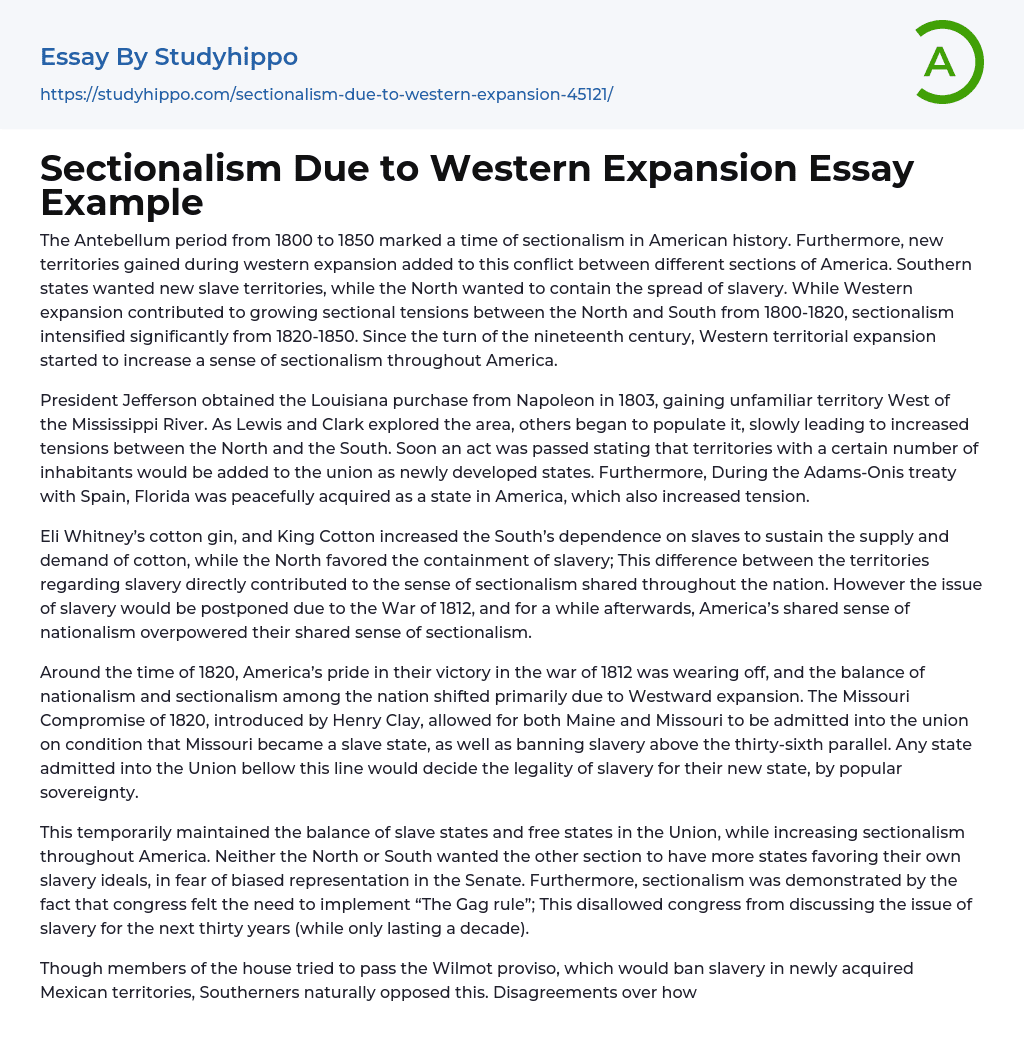The Antebellum period in American history (1800-1850) was marked by sectionalism, particularly due to the acquisition of new territories during western expansion. This further divided different regions of America, as the Southern states sought new territories for slave labor while the North aimed to limit slavery's expansion. While tensions between the North and South were heightened by Western expansion from 1800 to 1820, it was from 1820 to 1850 that sectionalism significantly intensified. Throughout the nineteenth century, Western territorial expansion fostered a sense of sectionalism across the entire nation.
President Jefferson obtained the Louisiana purchase from Napoleon in 1803, acquiring unfamiliar territory West of the Mississippi River. As Lewis and Clark explored this region, it began to be settled, resulting in increased tensions between the North and South. Consequently, an act was p
...assed stipulating that territories with a certain population would join the union as new states. Moreover, during the Adams-Onis treaty with Spain, Florida was peacefully obtained and became an American state, further heightening tension.
The cotton gin, invented by Eli Whitney, led to the expansion of the cotton industry in the South and increased reliance on slavery to meet the growing demand for cotton. This created a division between the North and South, with the North pushing for restrictions on slavery. The issue of slavery contributed to sectionalism across the country. However, during the War of 1812, concerns about slavery were briefly put aside as a sense of national unity prevailed over regional disagreements.
In 1820, the balance between nationalism and sectionalism in America underwent a shift as a result of Westward expansion. This led to a decline in pride
over the war of 1812 victory. The Missouri Compromise of 1820 was proposed by Henry Clay as a solution, allowing both Maine and Missouri to join the union. To be admitted, Missouri had to become a slave state, while slavery was prohibited above the thirty-sixth parallel. Whether any state below this line would allow slavery or not would be determined by popular sovereignty.
This temporarily preserved the equilibrium between slave states and free states in the Union, while intensifying sectionalism across America. Both the North and the South opposed any increase in the number of states favoring their respective ideal on slavery, as they feared biased representation in the Senate. Additionally, sectionalism was evident in Congress's decision to enforce "The Gag rule," which prevented any discussion on the issue of slavery for the following thirty years (although it only remained in effect for a decade).
Despite attempts by members of the house to pass the Wilmot proviso, which aimed to prohibit slavery in newly acquired Mexican territories, it faced opposition from Southerners. This disagreement over determining the stance on slavery in the newly acquired land further heightened sectionalism between the North and South. The South even attempted to purchase Cuba from Spain and bring it into the Union as a slave state, leading to the proposal of the Ostend Manifesto.
Despite its failure, the effort made during this time exemplifies the intense sectionalism experienced. A significant portion of the country acted independently in their quest to gain power over their Northern counterparts by securing an additional state. Ultimately, the compromise of 1850 was enacted, which established popular sovereignty as the determining factor
regarding the position of slavery in the newly acquired land from Mexico. Additionally, this compromise enforced a fugitive slave law, granting the South the ability to recapture runaway slaves. Furthermore, it abolished the slave trade in Washington D.C. and admitted California as a free state.
Despite Congress implementing numerous compromises in order to unite America, their endeavors were in vain as sectionalism prevailed and the United States moved closer to an unavoidable Civil War. The expansion of the West in the early 1800s, coupled with escalating tensions between the North and South regarding slavery, heightened the division between these regions. The dispute over controlled land escalated the nation's strong sense of nationalism into an even stronger sense of sectionalism, ultimately paving the way for a Civil War just half a century later.
- Malcolm X essays
- Black Lives Matter essays
- Antisemitism essays
- Ku Klux Klan essays
- Miscegenation essays
- Racial Segregation essays
- I Have a Dream essays
- Martin Luther King essays
- Racial Inequality essays
- Black History Month essays
- Black People essays
- Slave Trade essays
- Culture essays
- Social Control essays
- Citizenship essays
- Social Justice essays
- Caste System essays
- Social Responsibility essays
- Socialization essays
- Deviance essays
- Modern Society essays
- Popularity essays
- Civil Society essays
- Community essays
- Female essays
- Filipino People essays
- Igbo People essays
- Indigenous Australians essays
- Indigenous Peoples essays
- Minority Group essays
- Social Institution essays
- Men essays
- The nation essays
- Middle Class essays
- Social Norms essays
- Discourse Community essays
- Popular Culture essays
- Car Culture essays
- American Culture essays
- Mormon essays
- Indian Culture essays
- Mexican Culture essays
- Pop Culture essays
- Cultural Differences essays
- Culture Shock essays
- Different Cultures essays
- American Civil War essays
- Atomic Bomb essays
- Attack essays
- Cold War essays




